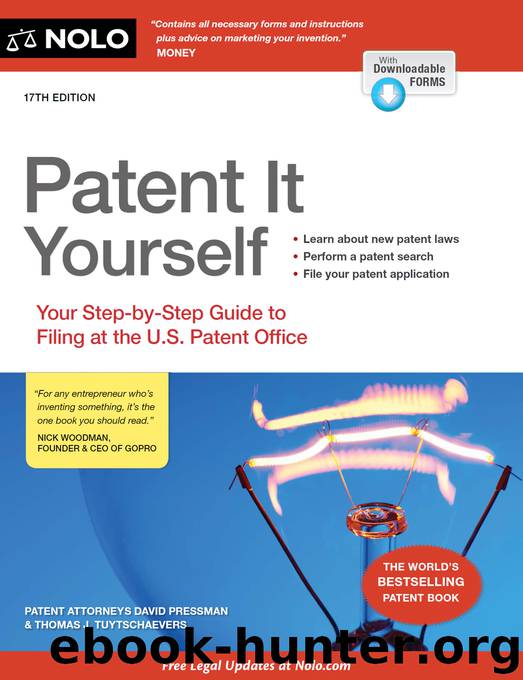Patent It Yourself: Your Step-by-Step Guide to Filing at the U.S. Patent Office by Pressman David & David Pressman & Thomas J. Tuytschaevers

Author:Pressman, David & David Pressman & Thomas J. Tuytschaevers [Patent Attorneys]
Language: eng
Format: epub
ISBN: 978-1-4133-2045-9
Publisher: Nolo
Published: 2014-09-12T04:00:00+00:00
2. The Drafting
For the reasons above, when you’re satisfied with your first, basic, and broadest independent claim, you should write as many dependent claims as you can think of, keeping in mind that the PTO charges extra if the total number of claims exceeds 20. Each dependent claim should begin by referring to your basic claim, or a previous dependent claim, using its exact title.
EXAMPLE:
Independent claim:
1. A cellular telephone having a hinged body and a coiled antenna.
Improper dependent claim:
2. The hinged body of claim 1 wherein said hinge has five knuckles. [The preamble or beginning of the claim does not correspond with claim 1 and there’s no antecedent for “said hinge.”]
Proper dependent claim:
2. The cellular telephone of claim 1 wherein said hinged body includes a hinge with five knuckles.
If the dependent claim recites one or more elements of the independent claim more narrowly, it should use the word “wherein”—for example, “The bicycle of Claim 1 wherein”—and then continue by reciting one or more elements of the independent claim.
Note that a dependent claim does not narrow the scope of any previous claim from which it depends; it merely provides an alternative, narrower recitation in a shorthand manner.
If the dependent claim recites additional elements, it should use the words, “further including” or “further comprising”—for example, “The bicycle of Claim 1, further including . . .”—then continue by reciting the additional feature(s) of your invention. The additional features can be those you eliminated in broadening your basic claims and all other subsidiary features, including all combinations and permutations of such features of your invention you can think of. The features recited more narrowly or the additional elements recited by the dependent claims can be specific parameters (such as materials and temperatures) or other specifics of your invention (such as specific shapes, additional elements, or specific modes of operation). Refer to your prior art patents for guidance on how to draft these.
Note that a dependent claim must either recite the elements of its parent claim more specifically, or recite additional elements. It may not change any element to a different type or kind. Thus if the parent claim is an apparatus claim, each of its dependent claims must recite additional structure or recite some previously recited structure more specifically. For example, if your parent claim recites “1. A house made of red bricks,” its dependent claim can say “2. The house of Claim 1 wherein said bricks are made of clay” (recites bricks more specifically) or “2. The house of Claim 1, further including a layer of paint over said bricks” (recites additional structure). The dependent claim can’t say “2. The house of Claim 1 wherein said bricks are yellow.” A method claim may not be made dependent upon an apparatus claim and vice versa, but most examiners will allow an apparatus claim that is dependent upon a method claim.
If the parent claim is a method claim, each of its dependent claims must recite an additional step, or recite a previously recited step (or structure in such a step) more specifically.
Download
This site does not store any files on its server. We only index and link to content provided by other sites. Please contact the content providers to delete copyright contents if any and email us, we'll remove relevant links or contents immediately.
You Don't Own Me by Orly Lobel(1147)
Hello, My Name is Awesome by Alexandra Watkins(1087)
Intellectual Property Strategy by John Palfrey(1083)
Without Copyrights by Spoo Robert(980)
Democracy of Sound by Alex Sayf Cummings(964)
Profit From Your Idea: How to Make Smart Licensing Deals by Attorney Richard Stim(942)
A Triumph of Genius: Edwin Land, Polaroid, and the Kodak Patent War by Ronald K. Fierstein(907)
World War 3.0 by Ken Auletta(906)
The Trademark Guide by Lee Wilson(898)
Kafka's Last Trial by Benjamin Balint(850)
Data Protection: A Practical Guide to UK and EU Law by Carey Peter(844)
Patent It Yourself: Your Step-by-Step Guide to Filing at the U.S. Patent Office by Pressman David Attorney(823)
What They'll Never Tell You About the Music Business by Peter M. Thall(820)
BVR's Guide to Intellectual Property Valuation by Michael Pellegrino(815)
Mass Media Law by Pember Don & Pember Don(815)
Hello, My Name Is Awesome: How to Create Brand Names That Stick (BK Business) by Alexandra Watkins(810)
The Tech Contracts Handbook: Software Licenses and Technology Services Agreements for Lawyers and Businesspeople by David Tollen(794)
The Copywriter's Handbook by Robert W. Bly(790)
The New Censorship: Inside the Global Battle for Media Freedom by Joel Simon(771)
